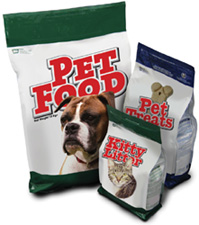There are many variables when it comes to picking the right package to store your product. The most important factors are packaging your product based on your ingredients, storage specifications and overall shelf-life required. Above all else, you want to make sure your product will last on the market for more than a few weeks. This factor is always debated when trying to decrease your carbon footprint in various marketplaces. Rather than getting too caught up on how to make your package more green, the more important factor is to consider that the right package protection be in place to prevent food waste! 
Packaging plays a critical role in protecting fresh produce and various food in transit, in storage, at point of sale, and prior to consumption.
The items in the freezer section have the benefit of being a frozen product and offer an automatic extended shelf-life. Using recyclable film for this application can be easier due to less outside environmental harm that could happen to the product. HDPE and LDPE can be used in various ways to make sure your product is protected against freezer burn while also being 100% recyclable.
Refrigerated sections can be a little bit more difficult. Making sure your ingredients are protected from excess oxygen and light from the storage area itself. Recyclable material can still be used; however, if oxygen or moisture protection is critical to the product shelf-life, a single-ply structure that would be considered 100% recyclable would typically not be an option. Flexible packaging films that have oxygen barriers are constructed by laminating various films together or blending various film properties together when making the film. Due to this process the film is no longer considered recyclable.
Shelf-stable or dry products can also be a challenge. Depending on the product, it may need to be protected from oxygen, moisture, and even sun light from hitting the product. We can take care of all of these issues by laminating structures together to create an "impenetrable" shield of protection. The type of packaging needed in these types of situations may not be the most "green"; however, will protect the product far better and will allow the end-user to purchase that product, without the added preservatives, and still have a fresh product when they open that package.
So what kind of package protection do you need? Do you want your customer to see the recycle logo or do you want your customer to eat a product that tastes as good on day one as it would taste on day 45? Are you willing to sacrifice the quality of the product and the loss of return customers due to stale or poor quality product? These are questions that companies battle against all the time. There are certainly opportunities to minimize food waste through packaging innovation and design, such as improved ventilation and temperature control for fresh produce, and better understanding the dynamics between different levels of packaging, to ensure they are designed fit-for-purpose. Call Flexaco - let us help you find a package that works best for your application.
